For many years now, I’ve picked away at redesigning the Taroc, or Tarot, as it’s commonly known today. I’ve never found another deck that really works for me: most attribute wands to fire and swords to air, which has never suited me; and while I’d like the “minor” or pip cards to have pictures, I have very specific pictures in mind: an ancient set of 36 curious magical images derived from Greco-Egyptian astrology and attributed to the zodiacal decans: the 10-degree subdivisions of the heavens. These images were preserved by Arab mystics after pagan learning was suppressed under Christianity, and filtered back into Europe in the 13th century, possibly via the court of Frederick II. They were later revived by Renaissance magician Giordano Bruno in conjunction with his “Art of Memory”, which used the striking images simultaneously as a mnemonic and a means of transforming the psyche. Although the images are beautifully suited to the Tarot, few people have yet tried to use them in this way.
The deck I’m creating is a very deliberately crafted magical tarot, rich in symbolism and well-founded in traditional occult philosophy. Unlike many occult tarots, it doesn’t strictly follow the conventions set by the Golden Dawn—a famous Victorian magical society which codified many structures of modern ceremonial magic—but seeks to revise and improve those structures, drawing on other and older sources of wisdom.
Development of occult Tarot
Playing cards, and probably tarot cards, have been used for divination at least since the 16th century. But it was only in the late 18th Century that esoteric theories and instructions for divination were first published. Correspondences were immediately found between the trumps or major arcana and the letters of the Hebrew alphabet (both 22 in number), though with disagreements over which cards belonged to which letters. The Hermetic Order of the Golden Dawn came up with the most lasting attributions in the late 1800s, based on a close reading of the Sefer Yetzirah and swapping the traditional ordering of Justice and Strength. Their “corrected” ordering has been copied by most decks since, though a slightly different ordering was popularised by the magician Aleister Crowley among his ‘Thelemite’ followers.


The pip cards of early decks (numbers 2 to 10 in each suit) tended to be bland and repetitive, consisting of geometrical arrangements of swords, batons, coins or cups. One exception was the Sola-Busca tarot, an engraved and hand-painted deck published around 1491, which gave every pip card its own dramatic image, based on alchemical and historical themes. This deck was much admired by Arthur Edward Waite, a Golden Dawn magician, and he copied the idea — and many of the images — for his own tarot, beautifully illustrated by Pamela Coleman-Smith and published in 1910. The Waite deck is the most influential of the modern decks, and its images form the leaping-off point for the vast majority of decks since.
Another widely loved tarot is the Thoth deck of Aleister Crowley — though much of the credit should go to Lady Frieda Harris, the accomplished artist who convinced Crowley it should be deeply magical, rather than traditional, and who executed it using “projective synthetic geometry” (an obscure artistic discipline within Anthroposophy) to produce a truly remarkable tarot. The Thoth deck follows the traditional geometric arrangements for pip cards, but manages to convey striking themes with them nonetheless. Unlike the Waite-Smith deck, the Thoth Tarot has spawned very few clones. It is simply one of a kind, a true magical artifact.
I like both the Waite-Smith and Crowley-Harris decks for different reasons; but I find them disappointing for either meditation or divination. For a start, both follow the Golden Dawn convention of attributing swords to air and wands to fire, which has never worked for me. Swords are forged in fire, are shaped like a flame, and throw sparks when clashed. They also have the forceful, piercing qualities classically attributed to elemental fire. The old English word “brand” means both a sword and a burning torch. The Hebrew lahab means both flame and blade. In the Book of Genesis a blazing sword guards the gates of Eden.
A rod, staff or wand, on the other hand, is literally solidified air, if you think about it: the substance of a tree is made up of carbon — drawn from the air — plus nitrogen — also from the air — plus water and some trace minerals drawn from the ground. When wood is combusted it turns back into air (carbon dioxide, nitrogen dioxide and water vapour), and the tiny residue of ash left behind is all that belongs to the earth. Trees are like inverted lungs, and they dance constantly when a breeze is blowing, so much so that we feel we can see the air moving when we watch a tree.
The usual explanation to support the fire-intellect attribution is that a keen intellect slices and dices to separate and refine concepts. This is a rather limited analogy, closely aligned to the reductive process of scientific rationalism, which is only one specialised mode of thinking, though an appealing one to intellectual pugilists like Waite and Crowley who were always ready to cut down their opponents. In general, though, mental processes have far more to do with forming connections than with slicing them apart.
The reordering of Justice and Strength (to correspond with astrological Libra and Leo) superficially makes sense, but deeper meanings are lost in the process. I tend to subscribe to the teachings of the late Michael Freedman, of the Society of Guardians, who believed rich symbolism was buried in the traditional ordering of the Tarot trumps.
Ancient images of the decans
Traditional or not, there was real insight in the Golden Dawn’s linking of the pip cards to the decans, the 10-degree “faces” of the zodiac. I heartily approve of Waite’s impulse to give the pip cards more suggestive imagery, and to base that imagery on the decans. I just think that his understanding of the decans was simplistic and at times inaccurate, and the images he chose reflect this. (In his defense, Waite was at the forefront of the occult revival, and had access to a tiny fraction of the material now available. We stand on the shoulders of giants.)
The exciting thing is, there are very old, traditional magical images for the decans already in existence, deriving from Greco-Egyptian astrological lore. The images are strange and striking, and far from simplistic. I believe they capture the dynamics of the decans with a great deal more nuance than Waite’s images, while evading complete rational explanation in much the same way that the images of the trumps do. To me this is one of the hallmarks of truly magical images. The images vary somewhat from source to source, but always retaining their important themes, I believe. I have modified these images slightly as the inspiration has taken me, and implanted in them the four magical implements — wand, cup, sword and coin.
 |  |  |
|
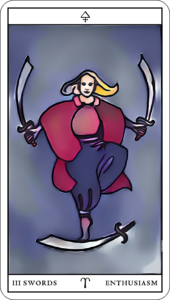 |  |  |  |
 |  | 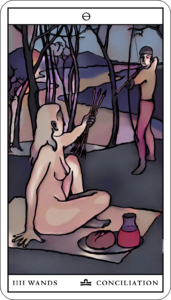 | 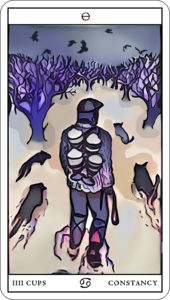 |
 | 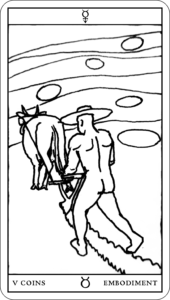 | 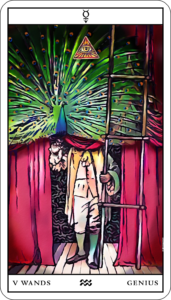 | |
 |  | 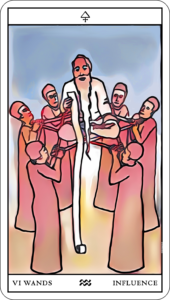 |  |
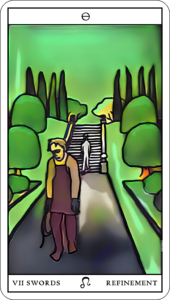 |  |  |  |
 |  |  | 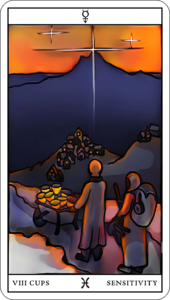 |
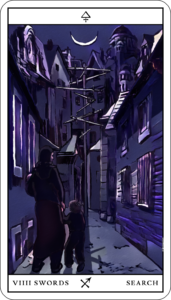 |  | 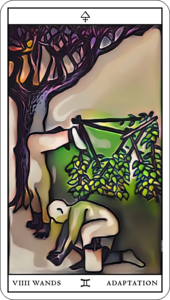 |  |
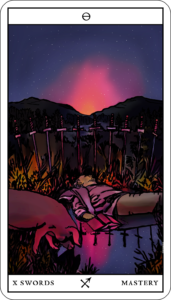 |  | 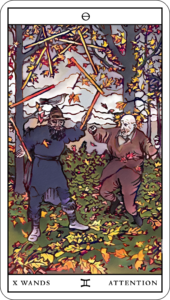 |  |
What I really like about these decan images and their astrological significations is that they succinctly capture both light and shadow. The images are neither good nor bad; like the hexagrams of the I Ching, they simply suggest the dynamic of the situation, and it is up to the reader’s skill and influence to determine whether these will manifest positively or negatively. As such, fatalism is not implied.
Because these cards map to the zodiac, it is possible to identify a person’s birth-card. I’ve looked at the significations for many friends and acquaintances, and found them usually remarkably apt in identifying both that person’s strengths and their inner wounds or weaknesses.
Some examples:
-
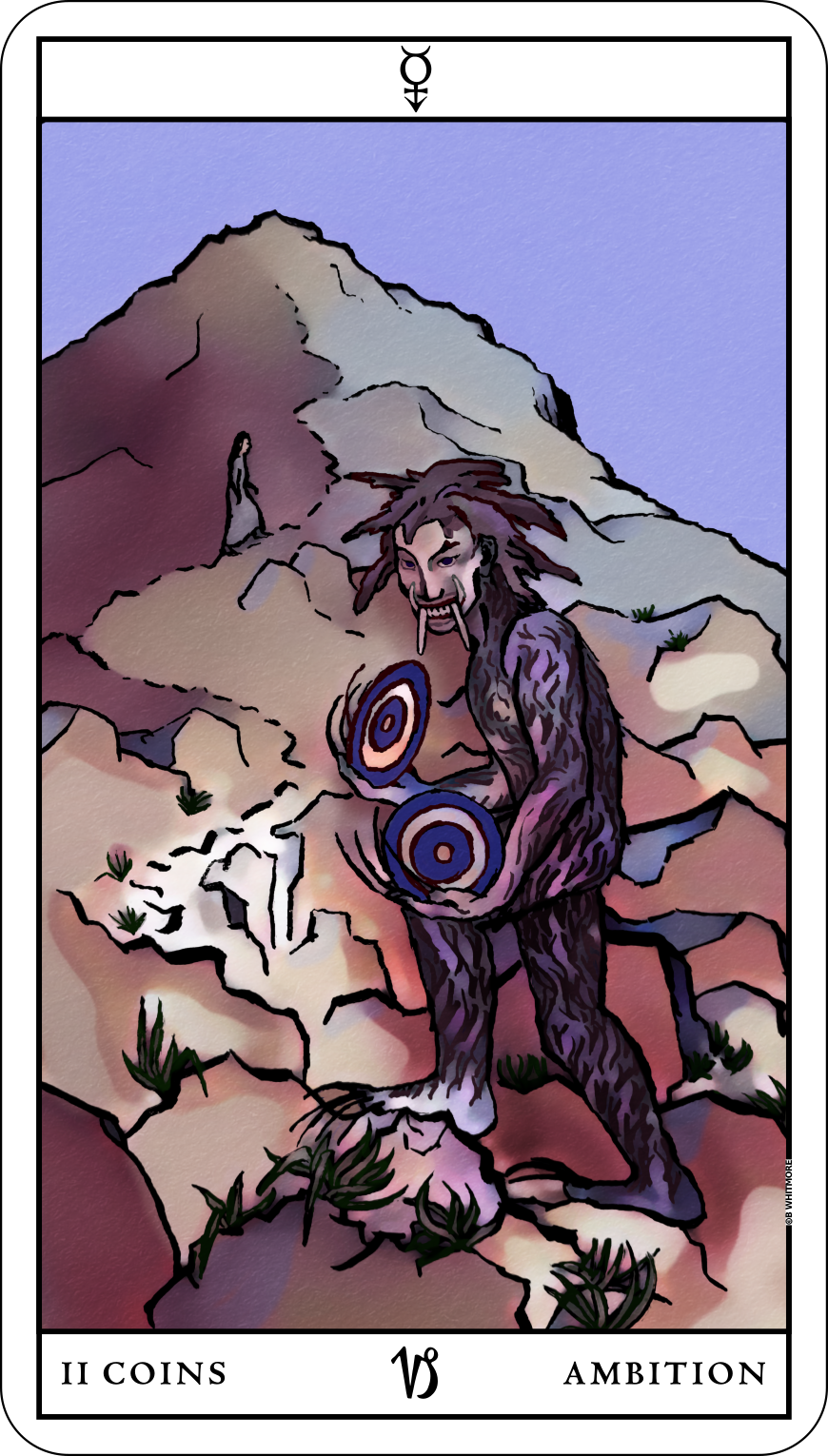 2 of Coins, “Ambition”: the first decan of Capricorn (22-30 December). A naked man, well-proportioned but very hairy, with extremely long teeth protruding from mouth and very long nails, carrying two discs up a mountain; some way ahead of him, a woman, also ascending.
2 of Coins, “Ambition”: the first decan of Capricorn (22-30 December). A naked man, well-proportioned but very hairy, with extremely long teeth protruding from mouth and very long nails, carrying two discs up a mountain; some way ahead of him, a woman, also ascending.
Traits: Aspiration, ambition, vocation, authority, relationship with parents, suffering from past demeaning experiences, struggle with authority, pain at lack of accomplishment, inadequacy.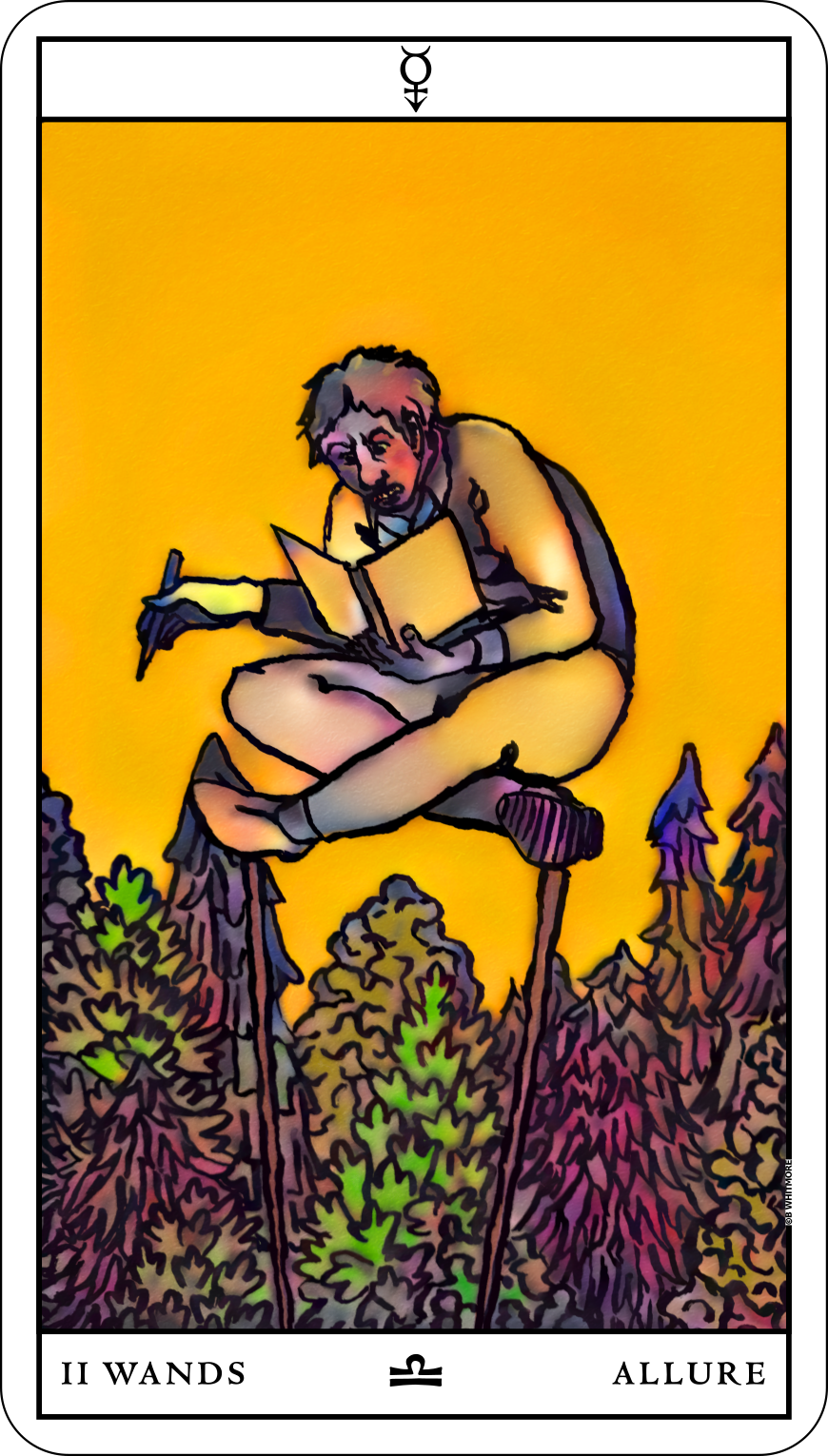 2 of Wands, “Allure” or “Captivation”: the first decan of Libra (23 Sept – 2 Oct). A young man sitting cross-legged high in the air, his feet balanced on two poles. He reads a book and holds a stylus, and has a look on his face like one being led to the slaughter. Evening sky and fir trees below.
2 of Wands, “Allure” or “Captivation”: the first decan of Libra (23 Sept – 2 Oct). A young man sitting cross-legged high in the air, his feet balanced on two poles. He reads a book and holds a stylus, and has a look on his face like one being led to the slaughter. Evening sky and fir trees below.
Traits: Love, attraction, full experience of oneself in relationship; hurtful behaviour, difficulty relating, giving away power, obsession, manipulation, “white lies”, co-dependency.
-
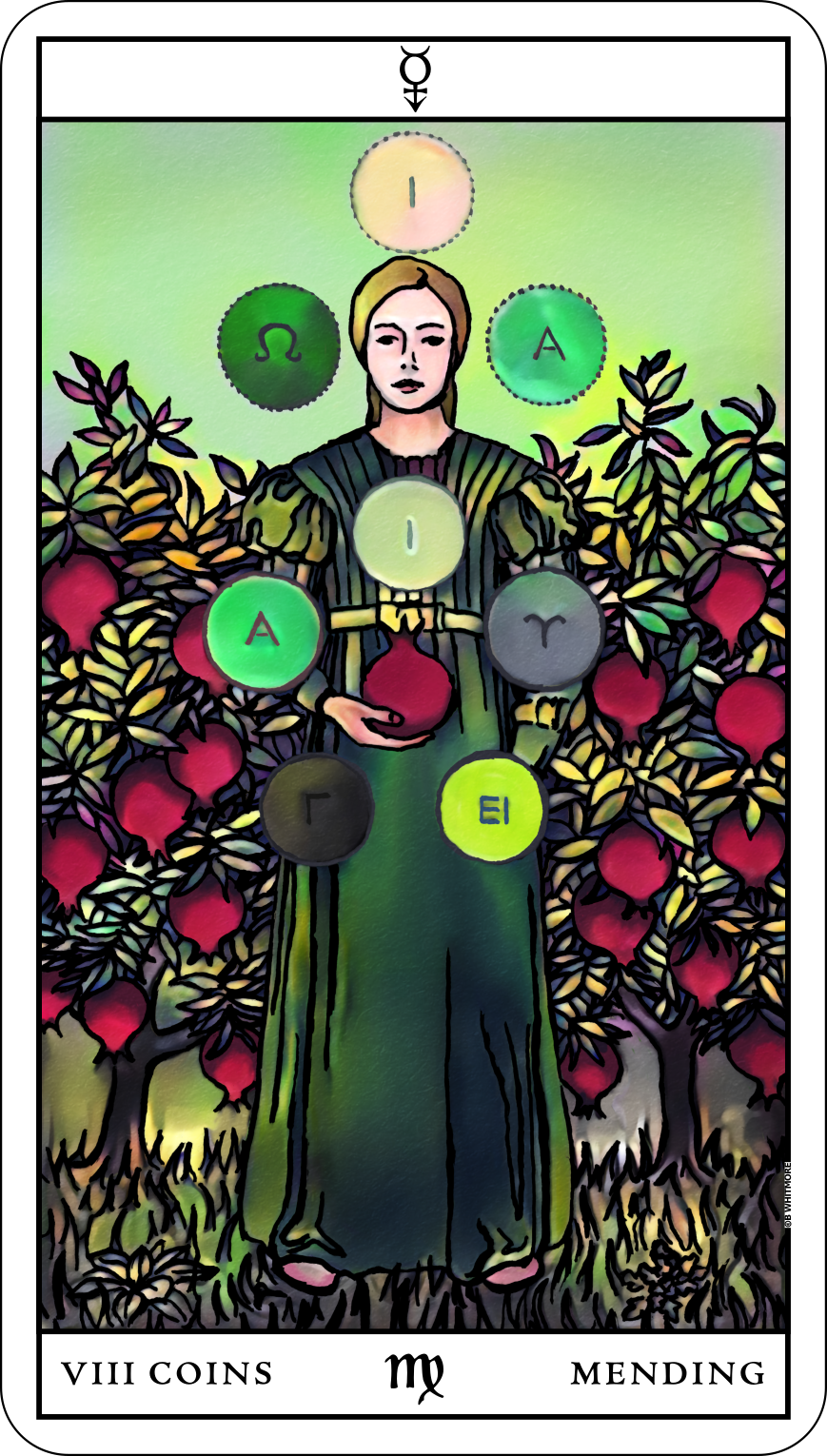 3 of Cups, “Nurture”: the second decan of Cancer (2-11 July). A woman crowned with myrtle stepping into a lily-pond to plant a waterlily she holds in a large cup. Flanking her, atop two pedestals, are similar cups containing waterlilies. Lush garden surrounds the pond.
3 of Cups, “Nurture”: the second decan of Cancer (2-11 July). A woman crowned with myrtle stepping into a lily-pond to plant a waterlily she holds in a large cup. Flanking her, atop two pedestals, are similar cups containing waterlilies. Lush garden surrounds the pond.
Traits: Nurturing, kindness, sympathy, smothering, over-concern.- 8 of Coins, “Mending”: the first decan of Virgo (23 Aug – 1 Sept). A pale maiden, crowned with flowers and wearing woollen (or green?) garments. She holds a pomegranate. Disk colours: Υ (water): sea blue-green; Γ (earth) brown-green; Ι (spirit) very pale green; ΕΙ (fire) strong yellow-green; Α (air) light turquoise green. Ω very dark, strong green.
Traits: Clarity, order, discernment, sees oneself as part of whole, healing. Self-rejection, disorder. Humiliation, pain or anger over imperfection or health.  3 of Swords, “Enthusiasm”: second decan of Aries (31 March – 10 Apr) A woman in white clothes and a richly-coloured loose coat, spinning on one foot. She holds a sword in each hand and a sword is beneath her. She wears a laurel wreath.
3 of Swords, “Enthusiasm”: second decan of Aries (31 March – 10 Apr) A woman in white clothes and a richly-coloured loose coat, spinning on one foot. She holds a sword in each hand and a sword is beneath her. She wears a laurel wreath.
Traits: Enthusiasm, optimism, impatience, scattered energies.
When most of the images were already settled, I became aware of two other decks that used the decan images: the Tarot of Stars Eternal by Roberto Negrini and Andrea Serio takes Lady Freida Harris’s and Crowley’s Thoth deck as a starting point, and further embellishes the pip cards with decan images drawn from the same sources I have consulted, but to somewhat different effect. And the Picatrix Decan Cards, a deck of 36 collage/assemblage images based on the Picatrix, by J Swofford.
Other cards
Several other tweaks are inspired by the Society of Guardians. This little-known magical order has a very rich Qabalistic tradition which seems to have developed quite independently of the Golden Dawn, and is more deeply rooted in traditional Jewish sources. They too allocate Hebrew letters to the Tarot trumps, but they keep the traditional ordering and leave the images of the trumps essentially unchanged from traditional old decks.
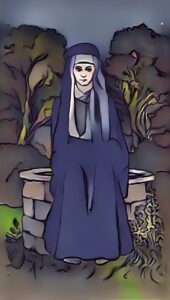 | |||
 |  |  |
|
 |  | 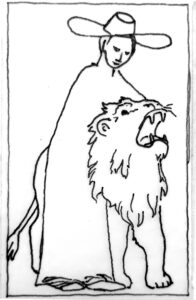 |
|
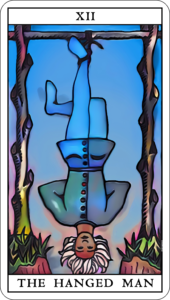 |  |  |  |
 |  | 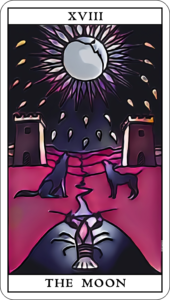 |  |
 |  | 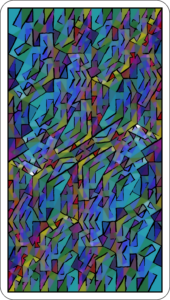 |
Among the cards that are substantially modified in their deck are the Aces, and I have drawn on their symbolism. Here you can see the Ace of Cups which contains the crashing sea of outer chaos; the peaceful world outside is actually the world of creation within that chaos.
 | 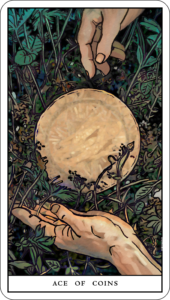 |  |  |
Based on a close reading of the Sefer Yetzirah, the Society of Guardians attribute air (wands, kings) to the world of Atziluth and fire (swords, knights) to the world of Yetzirah. My court cards conform to this same scheme, and among many other things they also draw on:
- Elemental symbolism: King of Coins is thus the “airy” manifestation of Earth; Knight of Cups is “Fire of Water”; etc.
- Keirsey temperaments: I find these relate more directly to classical theories of the elements than the Myers-Briggs or Jungian schemes, though these latter can also be derived.
- The 16 signs of Geomancy as attributed to the elemental pairings.
So for example the Knight of Coins (Fire of Earth) is a “Crafter, instrumenting” in the Keirsey system or ISTP in Myers-Briggs; Caput Draconis in the Geomantic signs. The knight faces a rocky outcrop with a dark doorway.
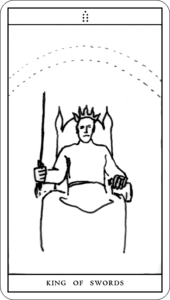 |  |  | |
 |  | ||
 | 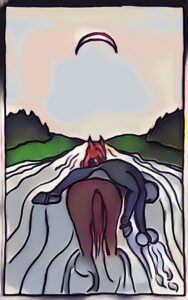 |
||
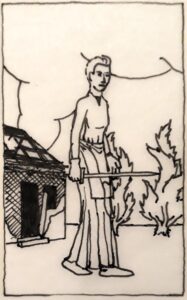 |  | 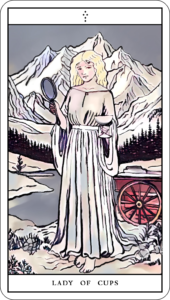 |
Structure
This Tarot differs from other common decks in several respects:
Swords and Wands are attributed to the elements of fire and water respectively. This reverses the common Golden Dawn attribution of swords to air and wands to fire. Earlier published attributions of suits to elements were different again: Eteilla had batons as earth, coins as fire and swords as air.
The 36 numbered suit cards (excluding the aces) were associated by the Golden Dawn with the decans, ten-degree segments of the zodiac that had considerable significance in Neoplatonic astrology and magic. Each of these decans has a traditional image, or more accurately images, since variations of these images are found in various languages and locations across time, and can differ substantially, probably partly as a result of mistranslations. Sources include the Ghāyat al-Ḥakīm or its Latin translation, the Picatrix; a 3rd Century Sanskrit poem; Heinrich Cornelius Agrippa; the 12th Century Spanish Jew Ibn Ezra, and Renaissance magician Girodano Bruno. Other versions of the images have since been devised by the Hermetic Order of the Golden Dawn.
The astrological connotations of the decans provide a rich set of associations for these cards. The most elegant and practically useful associations I first encountered in relation to Franchelle Ofsoske-Wyber’s New Zealand Native Flower Essences, the first 36 of which correspond to a decanate system. I was intrigued to see how these related to 36 archetypal personality types (or tendencies) in which the positive and shadow sides often pull in quite opposite directions. These cards, then, convey both positive and negative potentials; none are specifically fortunate or unfortunate. As with the I Ching, these should be read as indicating certain dynamics at play which can have positive or negative outcomes depending partly on how skillfully one recognises and approaches the situation. This tarot then becomes a tool for advice rather than simple fortune telling.
Tarot, as with astrology (and any symbolic system that contains wisdom) maps out ways in which creation occurs and things come into being.
Each major zodiacal sign is divided into three faces, to which I have ascribed the three alchemic principles of mercury, sulphur and salt, also corresponding to the three Vedic gunas. Passing through each sign in turn we encounter first the mercurial influence of the sign, which is responsive, reflective, stirred by some stimulus. Then the sulphurous influence, with self-sustaining momentum. Then the salty influence, in which that momentum crystalises into a purified, uncompromising form. The stagnation of the salty phase provides the soil from which the mercurial seeds of the next cycle spring. These phases can also be related to the phases of creativity, in which a process of searching leads to flowing inspiration, which can in turn give way to something obsessive and repetitive.
The numbers assigned to the cards are very significant to the cycle. One, for the aces, is an essence and a potential, not yet come into relation with any external influence. Two is a number of reflection and relation; three is balanced, harmonious yet dynamic; four is stable and static. Five sees the creative spirit loosen the restrictions of form; six, the central number, enthrones that spirit in a dynamic and precarious balance; seven is a number of both dominion and tyranny. Eight seeks to restore reciprocity between spirit and form; nine sees the spirit guide and channel itself through form; and ten is complete absorption of spirit into form.
The decan stories of each suit from 2 to 10 can be briefly related thus:
Swords: A first impulse grows into enthusiasm and then into stubborn assurance. Boldness breaks the stasis of that assurance, growing into creative flair, which is refined until that very refinement oppresses creativity. Risk yields new openings, possibilities and uncertainties which become sought for their own sake; the cycle completes in the paradoxical mastery of the known through constant pursuit of the unknown.
Coins: An ambition inspires diligent dedication, but this diligence becomes prudish inflexibility. By yielding to the body’s innate wisdom, self-esteem and pleasure are unlocked, and thence a sensual luxury, but eventually a tyrannical control of all things material. Relaxing control allows healing, and thence growth, as receptivity expands and energies become responsive to circumstance. In the final phase, all energies are completely subjugated to manifest form.
Wands: An attraction leads to harmonious relation, which in turn motivates a selfless striving to maintain harmony. The self reasserts itself in flashes of genius, and establishes a new relationship of influence, which in turn becomes an adherence to group mind. By penetrating beneath convention a more adaptable way of relating and perceiving is enabled; this perception finally becomes passive, absorbed attention.
Cups:
The court cards
These follow a similar scheme to that of Waite, with each court card representing a secondary element through which the suit’s element is expressed. Thus the princess of swords is Earth of Fire, or Fire’s expression in solid, earthy form. There is a major point of difference from Waite: here Kings represent Air and Knights Fire. Waite chose the opposite associations, based on his interpretation of the Qabalistic ‘Four Worlds’, four phases through which creation occurs. The first, ‘Archetypal’ world he associated with the Kings and with Fire; the third, ‘Formative’ world he associated with Air and Knights. I follow a different tradition that understands the natures of the first two worlds in light of Genesis 1:2, in which the breath of God hovers over the face of the waters.
These elemental associations allow a further connection of the court cards with the 16 figures of Geomancy. Geomancy as its own system of divination carries many one-sided and prejudiced interpretations in the manuals of the Renaissance, and I hope this deck may help reveal more nuanced readings. I am sadly unfamiliar with the living tradition of Geomancy as it has survived to the present day in parts of Africa.
Style of artwork

I have experimented with various styles. There are Tarot decks I love the style of and would gladly emulate. I also experimented many years ago with a black and white photo-montage style I’ve not seen elsewhere, which I really love, but this would take a lot of effort to produce — not to mention that this would cut out all colour symbolism. Perhaps I will still produce this one day, when I have retired!
In the meantime I’ve been working between pen drawings and digital colouring. Many of the cards I’m still not happy with, and need to be redrawn.
Colours
The colours I’m using are guided by four colour-scales of the Sefiroth, but not those used by the Golden Dawn, except for the Queen Scale. The Queen Scale follows a systematic scheme and is appropriate to Briah/Water and the gradual obscuration of light through the mixing of primaries. But the other GD scales have always seemed arbitrary to me, and not very useful.
Instead, for Atziluth/Air/Wands the colours are based on light seen in different levels and conditions of the atmosphere, as a result of the scattering of different frequencies of light.
For Yetzirah/Fire/Swords, I use the colours given off by various metals under combustion.
For Assaiah/Earth/Coins, I use the colours of these same metals fixed in glass.
The colours the metals take in glass tend to be complementary to their colours under combustion, and for those metals where combustion does not cause the necessary leap of electrons for a coloured flame, I have derived a theoretical colour based on the metal’s colour in glass. And vice versa.
The images here are all copyright 2021 Ben Whitmore, apart from the two Sola Busca and Waite cards.
